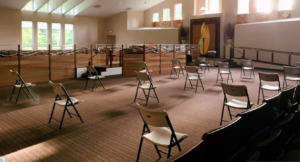What in the world are Jewish people to do this Rosh Hashanah? Non-Orthodox synagogues in the United States have mostly decided to remain closed and to run traditional holiday services over Zoom. This is a relief to many people who still do not feel comfortable praying or even being in a building with many people who still do not feel comfortable being indoors for extended periods of time with large groups of people—even if social distancing is enforced. Orthodox synagogues, which do not use technology on the Sabbath and holidays, are in a different situation.
I was pleased to read a recent JTA article which took a look at what Orthodox synagogue’s around the country are planning to do. Synagogues are working on “pacing and spacing,” (photo above is from JTA article–features an Atlanta shul), with services starting at Shaharit, and rabbis not to deliver sermons. Some synagogues are even running services in different shifts. Some are exploring the use of outdoor spaces, though this is not so easy to find—and the weather in many parts of the country is not so cooperative in late September.
In these shuls, some cantor’s will be wearing masks or praying behind Plexiglas. And there is speculation about how the shofar will be blown. Many synagogues are facing situations where older members will not attend due to health concerns and many younger members have left their home cities during the pandemic.
I received an email survey today from a New York City Orthodox synagogue which I belong to. Before launching in to a detailed questionnaire, the very kind letter begins by reminding members that the shul has always had an “open door” policy during the High Holidays, “offering all members of our community the opportunity to pray at our synagogue without reserving or paying for seats.” It goes on: “Unfortunately, during these unprecedented times, we are forced to implement different procedures and will require that all attendees register for seats in advance of the holidays.”
In a “typical” year, services begin 745 or 8 am and run until 1 or 1:30 pm. This year, the synagogue is planning to offer two services during the day on Rosh Hashanah (subject to demand by worshippers).
1. Full Service: This slightly abridged service will last approximately 2 ½ hours and include Shacharit, Torah Reading, Rabbi’s Remarks, Shofar Blowing and Mussaf. Expected start time is 7:45AM.
2. Limited Service: This shortened service will include Rabbi’s Remarks, Shofar Blowing and Mussaf. Expected start time is 11:15AM.
Additional features of the Rosh Hashanah plan:
* Total available seating will be limited to ensure social distancing.
* All seats will be assigned by the High Holiday Seating Committee.
* You may only enter the synagogue building if you received confirmation of a seating assignment and are on the security list. As of now, NO WALK-INS will be permitted.
It is wonderful to see that synagogues are taking the pandemic very seriously—and are carefully and sensitively making some very tough decisions. The plan above will be useful for those willing to enter a synagogue this year. With exactly a month and two days to go before Rosh Hashanah (Rosh Chodesh Elul is this Thursday and Friday!), it would be nice to see other creative options creative and meaningful options in place for those who do not feel comfortable or safe entering the synagogue. Hopefully, Orthodox synagogues will soon validate the concerns of those not attending and share info on “DIY Rosh Hashanah.” What rituals can be done at home as a family? Perhaps praying together as a family, blowing the shofar together, reading the Torah and Haftarah aloud in English, walking to tashlich, etc. Please share other suggestions for making the holiday meaningful in the age of Covid!


